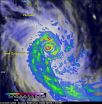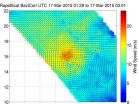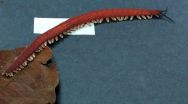Ras protein regulates circadian rhythm
Effects on period length and regulation through external time cues
2015-03-18
(Press-News.org) Biochemists at the Ruhr-Universität Bochum have gained new insights into the generation and maintenance of circadian rhythms. They demonstrated that the Ras protein is important for setting the phase of such a circadian clock, as its activity determines the period length of the rhythm. Ras is also contributing to induce phase-shifts in circadian rhythms in response to external time cues such as light. The team headed by Prof Dr Rolf Heumann published their results in the magazine "Molecular Neurobiology".
Ras activity varies throughout the day
The circadian clock "ticks" in every cell of the body; a central master clock, however, is located in the brain, more specifically in the Nucleus suprachiasmaticus of the hypothalamus, which is old in genealogical terms. Its activity determines the cycle's period length, which is close to but not exactly 24 hours; it has to be continuously adjusted by external signals such as light, motor activity or food intake to an exact 24-hour rhythm. Such regulation is the result of many proteins acting and interacting in various signal cascades. A central switch for such signal cascades is the Ras protein, which is present either in its active or in its inactive form. The group from Bochum demonstrated in mice that Ras activity in the Nucleus suprachiasmaticus is high during the day and low during the night. Moreover, Ras activity was increased after brief exposure to light during the night.
Artificially increased Ras activity alters the circadian rhythm
In collaboration with a Frankfurt-based team, headed by Prof. Dr. Jörg Stehle, the researchers from Bochum additionally studied the phenomenon in genetically modified mice, whose Ras activity is increased exclusively in neurons of the brain. They found that the activity in the Nucleus suprachiasmaticus oscillated with a significant shorter period than 24 hours - additional evidence for the relevance of Ras for the circadian rhythm.
Interplay with GSK3ß enzyme
The activity of the Ras protein is linked with the activity of an enzyme in the glycogen metabolism, namely GSK3ß. Via Ras, that enzyme is also involved in the regulation of circadian clock mechanisms. "Our findings are relevant in a larger context," says Rolf Heumann. "Other studies have shown that a dysregulation of the GSK3ß enzyme leads to major disturbances in circadian rhythms, and is linked to the symptoms of bipolar disorder."
INFORMATION:
Bibliographic record
T. Serchov, A. Jilg, C.T. Wolf, I. Radtke, J.H. Stehle, R. Heumann (2015): Ras activity oscillates in the mouse suprachiasmatic nucleus and modulates circadian clock dynamics, Molecular Neurobiology, DOI 10.1007/s12035-015-9135-0
Further information
Prof Dr Rolf Heumann, Work Group Molecular Neurobiochemistry, Faculty of Chemistry and Biochemistry at the Ruhr-Universität, 44780 Bochum, Germany, phone: +49/234/32-24230, email: rolf.heumann@rub.de
Editor: Dr Julia Weiler
ELSE PRESS RELEASES FROM THIS DATE:
2015-03-18
Absence, it seems, really does make the heart grow fonder.
That's according to research conducted by UC Santa Barbara anthropologists, who found that levels of the "love" hormone oxytocin increases among Tsimane men when they come home to their families after a day of hunting. The researchers also found that the increase in oxytocin was greater for those men who were absent longer, and it positively correlated with changes in testosterone. Their findings are published in the Royal Society journal Biology Letters.
The Tsimane are an indigenous population of forager-farmers ...
2015-03-18
For many, Facebook connects friends, family, and others with common interests. Despite the popularity of social networking sites like Facebook, scientists are only beginning to learn how they affect human interaction.
In a recent study published by the journal Social Science & Medicine, Dartmouth researchers examined nearly 9,000 Facebook conversations to better understand how people seek and receive support on social networking sites.
"Among the many Facebook conversations that were mostly casual, we noticed more serious exchanges among people who mentioned a major ...
2015-03-18
As one of the strongest cyclones every recorded in the South Pacific Ocean, Cyclone Pam devastated the island archipelago of Vanuatu. The Global Precipitation Measurement or GPM core observatory provided data on rain rates throughout the storm. At the end of Pam's life on March 17, NASA's RapidScat provided a look at the winds of the waning storm.
As the cyclone bore down on Vanuatu's central islands on the afternoon (local time) of March 13, 2015, Pam's maximum sustained winds were estimated to have increased to 270 kph (~167 mph) by the U.S. Joint Typhoon Warning Center ...
2015-03-18
New research shows that courtship rituals evolve very fast in cichlid fish in Lake Malawi. Whenever species evolve to feed at different depths, their courtship evolves as well. In the shallows where the light is good, males build sand castles to attract females. Males of deep-dwelling species dig less elaborate pits and compensate with longer swimming displays. The results are published in the open-access journal Frontiers in Ecology and Evolution.
"Lake Malawi cichlids are famous for the diversity and fast evolution of their feeding habits, body form, and sex determination ...
2015-03-18
Men and women who adapt their daily diet to meet current UK dietary guidelines could reduce their risk of a heart attack or a stroke by up to a third, according to a new study by King's College London.
The study, published in the American Journal of Clinical Nutrition, recruited healthy middle-aged and older men and women to compare the effects on risk factors for cardiovascular disease (CVD) of following a diet based on UK health guidelines compared with a traditional British diet. The predicted risk of CVD over the next 10 years for the participants was estimated to ...
2015-03-18
In diseases such as asthma and chronic obstructive pulmonary disease (COPD), the body produces too much mucus, making breathing difficult. New research from Washington University School of Medicine in St. Louis provides clues to potentially counteract inappropriate mucus production.
"The new study lays the groundwork for developing treatments for diseases such as asthma, COPD, cystic fibrosis and even certain cancers," said senior author Thomas J. Brett, PhD, assistant professor of medicine. "It also solves a 20-year mystery about the role of a protein that has long been ...
2015-03-18
Researchers at the San Diego Supercomputer Center (SDSC) and the Moores Cancer Center at the University of California, San Diego, have described for the first time the molecular mechanism of cancer development caused by well-known "resistance" mutations in the gene called epidermal growth factor receptor (EGFR).
While these mutations were known for quite a long time, the question as to why they cause cancer or make some drugs ineffective was still not answered.
The study, called "Molecular Determinants of Drug-Specific Sensitivity for Epidermal Growth Factor Receptor ...
2015-03-18
Tropical Cyclone Bavi weakened to a depression and NASA's RapidScat instrument measured its waning winds from space.
On March 17 the RapidScat instrument aboard the International Space Station (ISS) measured Bavi's surface winds from 01:28 to 3:01 UTC. RapidScat data showed surface winds were strongest winds in the northwestern quadrant. Sustained winds were near 17 m/s (38 mph/61 kph) and weaker around the rest of the storm.
On March 18 at 0000 UTC (March 17 at 8 p.m. EDT), the Joint Typhoon Warning Center noted that Bavi's maximum sustained winds dropped to 25 knots ...
2015-03-18
Cambridge, Mass. - March 17, 2015 - The velvet worm is a slow-moving, unassuming creature. With its soft body, probing antennae, and stubby legs, it looks like a slug on stilts as it creeps along damp logs in tropical climates.
But it has a secret weapon. In the dark of night, when an unsuspecting cricket or termite crosses its path, the worm unleashes an instantaneous torrent of slime. Two fine jets of the gluey substance spray out of openings on its head, oscillating in all directions to cast a sticky net that entraps prey and stops it in its tracks.
Captivated, ...
2015-03-18
While unconscious race and social class biases were present in most trauma and acute-care clinicians surveyed about patient care management in a series of clinical vignettes, those biases were not associated with clinical decisions, according to a report published online by JAMA Surgery.
Disparities in the quality of care received by minority patients have been reported for decades across multiple conditions, types of care and institutions, according to the study background. Adil H. Haider, M.D., M.P.H., of Brigham and Women's Hospital, Boston, conducted a web-based survey ...
LAST 30 PRESS RELEASES:
[Press-News.org] Ras protein regulates circadian rhythm
Effects on period length and regulation through external time cues



